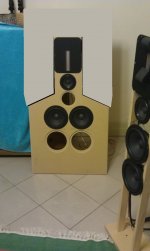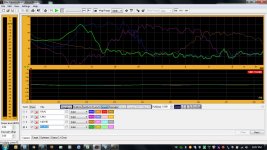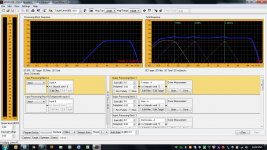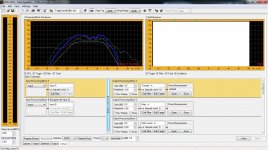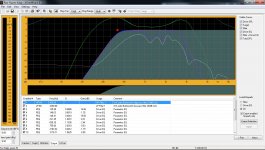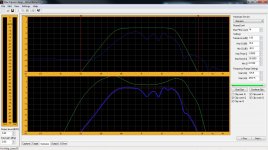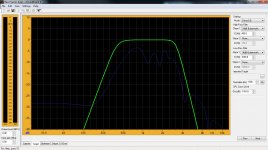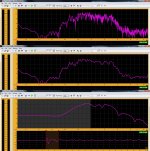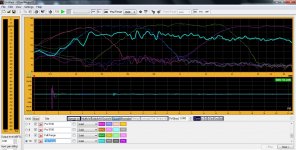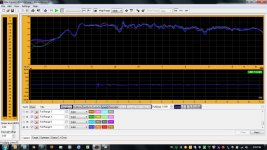Hi Greg, I am still in the early stages of learning how to measure. My plans at the moment are to just see if one design or another lends itself to producing better results, as you can see from the two graphs even with the lumpy looking response the mid bass improved when put on the baffle whereas the mid and tweeter not so much.
I have been using the 12MUs anywhere between about 1300Hz – 1600Hz and 3500Hz, you think I still need to go even lower to around 500Hz? That wouldn’t leave a great deal for the mid woofers then would it?
Yep had already looked at a modification of the top end to something more like this.
Want to experiment with measuring in different spots and distances before I start to chop.
I have been using the 12MUs anywhere between about 1300Hz – 1600Hz and 3500Hz, you think I still need to go even lower to around 500Hz? That wouldn’t leave a great deal for the mid woofers then would it?
Yep had already looked at a modification of the top end to something more like this.
Want to experiment with measuring in different spots and distances before I start to chop.
Attachments
Last edited:
Well, 1.5-3.5Khz is not a mid. It's more like a filler driver for a two way. Leave just the "impact and weight" region to the midbass and get all of the primary vocal region in the mids. You will probably have to EQ their low end response to bring it up as well, but ought to be a much more accurate way to go.
Greg
Greg
mid crossover point is also a trade off for power handling too isn't it?
I haven't read this article in a while but Rod Elliot has some discussion on crossover point selection in his bi-amping article. BiAmp (Bi-Amplification - Not Quite Magic, But Close) - Part 2
I haven't read this article in a while but Rod Elliot has some discussion on crossover point selection in his bi-amping article. BiAmp (Bi-Amplification - Not Quite Magic, But Close) - Part 2
mid crossover point is also a trade off for power handling too isn't it?
I haven't read this article in a while but Rod Elliot has some discussion on crossover point selection in his bi-amping article. BiAmp (Bi-Amplification - Not Quite Magic, But Close) - Part 2
Well, sure. Rod's site has lots of good info, but even he says that design is all about compromises. In section 2.0 just above where you linked, he mentions his preference for keeping the 300-3000Hz range intact and not using a crossover there. With Silent running two mids in parallel, I anticipate no problem running as low as 300Hz. Will it sound best? Who knows, but I'd start there and work up if necessary.
I set up two copies of the software one with the old crossover and one with the new. A very different sould but crossing over low and high does make is sound much crisper.
I also notice that I am not maintaining a high enough SNR. Its ok on the tweeter but by the time I get to the mid woofer it is too low cauasing all sorts of lumpy graphs.
3 out of the 4 were in the green for these measurements with only the woofer below acceptable. Notice how much more level it looks.
Also tweeked the crossover to start a bit flatter.
I also notice that I am not maintaining a high enough SNR. Its ok on the tweeter but by the time I get to the mid woofer it is too low cauasing all sorts of lumpy graphs.
3 out of the 4 were in the green for these measurements with only the woofer below acceptable. Notice how much more level it looks.
Also tweeked the crossover to start a bit flatter.
Attachments
I'm using the same software. And found out that instead of using smoothing. Try "Multiwin". I shows 3 red lines. One at 0 mm seconds, one to adjust gating and the third you just leave alle the way out where it is.
So - number two red line is the one to focus on. The first pulse, is when the first direct sound hits the microphone. So the trick is to find out how far the sound has to travel from the speakerunit - down to the floor, and up to the microphone(this is your first reflection). and if you find this distance in mm-seconds, and place the second red line at this point. Then you are actually canceling out the "room"
The 300hz dip. Might just be the room acoustics. Measuring low in frequency is hard. Because you have to remove reflecting surfaces. putting the speaker on a tabel, helps a little. You can also try to lay the speaker on its back and hang the microphone from above. The lower the frequency, the longer the waves. Therefore you have to move reflecting surfaces farther away
So - number two red line is the one to focus on. The first pulse, is when the first direct sound hits the microphone. So the trick is to find out how far the sound has to travel from the speakerunit - down to the floor, and up to the microphone(this is your first reflection). and if you find this distance in mm-seconds, and place the second red line at this point. Then you are actually canceling out the "room"
The 300hz dip. Might just be the room acoustics. Measuring low in frequency is hard. Because you have to remove reflecting surfaces. putting the speaker on a tabel, helps a little. You can also try to lay the speaker on its back and hang the microphone from above. The lower the frequency, the longer the waves. Therefore you have to move reflecting surfaces farther away
There's too much info shown on those measurement plots. It is very difficult to tell what each line represents. Can you download Room Eq Wizard and use that with your mic and soundcard? It's very simple to use and very powerful as well. Or at least find a way to only show a non-gated nearfield or a lightly gated 1 meter response of the whole system rather than driver by driver? There's got to be a choice in the software to turn off some of the traces.
Greg
Greg
Thanks Tordenguden, at the moment I am just trying to get the get the basic speaker design as good as I can get it without any correction. I am using smooth simply to get a line that can be viewed (the non-smooth is impossible to view properly) not trying to get it as good as I can.
By using just the smooth I can do a much more “fair” comparison of each reading, as using MultiWin does alter each curve quite differently based on the amount of time spent refining it.
Robert has already given me a few clues on how to use the MultiWin, and I have experimented with varying degrees of success. You mention that you leave the first line at the far left (0ms) and move the second red line to the floor bounce (start of first bump). I was under the impression that you put the first red line at the point of floor bounce and the second and third red lines to the right of that. I might give what you’re doing a go and see how that goes.
I have been giving it some thought as to how to measure, and really are we just kidding ourselves if we measure to get optimal results when we would get a different result from our listening position. Which has led me to think perhaps the truest way of measuring the speakers is to place the mic at ear height in the seated position, as that is where your ears are going to be placed while listening to the speakers. Should we really be adjusting the speakers to get the best results there?
By using just the smooth I can do a much more “fair” comparison of each reading, as using MultiWin does alter each curve quite differently based on the amount of time spent refining it.
Robert has already given me a few clues on how to use the MultiWin, and I have experimented with varying degrees of success. You mention that you leave the first line at the far left (0ms) and move the second red line to the floor bounce (start of first bump). I was under the impression that you put the first red line at the point of floor bounce and the second and third red lines to the right of that. I might give what you’re doing a go and see how that goes.
I have been giving it some thought as to how to measure, and really are we just kidding ourselves if we measure to get optimal results when we would get a different result from our listening position. Which has led me to think perhaps the truest way of measuring the speakers is to place the mic at ear height in the seated position, as that is where your ears are going to be placed while listening to the speakers. Should we really be adjusting the speakers to get the best results there?
No, do not begin at the listening position. There is to much room interaction to see clearly the native response of the system. Or you'd have to gate it so much that all low frequency resolution will be lost. Start nearfield, get it well balanced close to flat or with a gradual downward tilt towards the highs and THEN see what you're getting at the listening position.
Hey Greg, the software has plenty of options for EQ built in. I am just trying to avoid colouring the results by using them at the moment. I can select and deselect just about anything in the software.
In pic 1 at the top is the raw capture, below that is with a basic smooth applied, below that is with MultiWin (gating) applied.
In pic 2 you tell the software what crossover slope you are aiming for so it know what to match it to.
In pic 3 it optimises the captured results to make it fit the desired crossover pattern as best it can (double red dotted lines)
In Pic 4 it shows what EQing is going to be applied to the Xover
In Pic 5 it shows the corrections added to the crossover (blue line)
You have to go through each of the drivers in turn to create an overall map of the drivers, after repeating the process for all drivers hopefully that thick blue line will be flat from start to end.
In pic 1 at the top is the raw capture, below that is with a basic smooth applied, below that is with MultiWin (gating) applied.
In pic 2 you tell the software what crossover slope you are aiming for so it know what to match it to.
In pic 3 it optimises the captured results to make it fit the desired crossover pattern as best it can (double red dotted lines)
In Pic 4 it shows what EQing is going to be applied to the Xover
In Pic 5 it shows the corrections added to the crossover (blue line)
You have to go through each of the drivers in turn to create an overall map of the drivers, after repeating the process for all drivers hopefully that thick blue line will be flat from start to end.
Attachments
No, do not begin at the listening position. There is to much room interaction to see clearly the native response of the system. Or you'd have to gate it so much that all low frequency resolution will be lost. Start nearfield, get it well balanced close to flat or with a gradual downward tilt towards the highs and THEN see what you're getting at the listening position.
If I understand correctly you are saying measure each driver nearfield first to avoid room interference, work out the EQ corrections from there, apply and then listen to it from seated position?
Well IF you are doing all of this manually, yes. BUT if I am understanding you correctly, the Ground Sound DSP is auto-magically performing all of the xover and EQ corrections to achieve the target functions, yes? If that's the case, I'm not sure what the best method is, but it still seems to me that the cleanest adjustments will come from the least amount of room interaction. And THEN, maybe you can manually adjust for taste?
What does Ground Sound recommend?
Greg
What does Ground Sound recommend?
Greg
Robert had suggested measuring from a bit further away for OB. Being that I am basically living in a rented shoe box (close to the city) until next year, further away equates to my listening position (which is still only ~2m)
There is still some manual magic required once you capture the driver response, as there is some "skill" involved in getting the gating right, but after that it is pretty much next, next, next.
Some of my early automatic attempts were woeful to say the least, but the better I capture the initial reading, the better I find the EQing sounds. Some of my earlier problems have been tracked down to SNR that was too low, and some cabling issues.
That was kind of why I threw the question out there, should I be measuring from my seated position where my ears are? Or should I be trying to measure in near field to avoid room errors creeping in, I am tempted to think because the software is accounting for room reflection that once I gate it best I can, I am probably best trying to measure from further away. Keen to hear everyone’s thoughts on that.
There is still some manual magic required once you capture the driver response, as there is some "skill" involved in getting the gating right, but after that it is pretty much next, next, next.
Some of my early automatic attempts were woeful to say the least, but the better I capture the initial reading, the better I find the EQing sounds. Some of my earlier problems have been tracked down to SNR that was too low, and some cabling issues.
That was kind of why I threw the question out there, should I be measuring from my seated position where my ears are? Or should I be trying to measure in near field to avoid room errors creeping in, I am tempted to think because the software is accounting for room reflection that once I gate it best I can, I am probably best trying to measure from further away. Keen to hear everyone’s thoughts on that.
Have you considered a 3-Way+Sub? Looking at your drivers, I'd be so tempted to stack them as a line. WWMRaalMWW and let the 18" (in a simple U frame) add to the lowest octave. A simple narrow-ish (hourglass maybe) baffle with more wing(s) around the woofers. Just for kicks anyway.
Ok well for those playing along at home we have measurements at two different distances.
First measurement from left to right Woofer, Mid Woofer, Mid & Tweeter at 6” - 7” each. Mids measured between the two drivers and the mid woofers measured from centre off all four WU18s.
Second measurement is from seated position (~2m) at ear height. All measurements are with high SNR.
Each measurement was done twice, so there are two lines for each measurement.
Bass roles off as expected being that it is further off axis than the tweeter and mids. Couple that with the mic is pointing pretty much at the tweeter and not the Pro 5100 baffle.
First measurement from left to right Woofer, Mid Woofer, Mid & Tweeter at 6” - 7” each. Mids measured between the two drivers and the mid woofers measured from centre off all four WU18s.
Second measurement is from seated position (~2m) at ear height. All measurements are with high SNR.
Each measurement was done twice, so there are two lines for each measurement.
Bass roles off as expected being that it is further off axis than the tweeter and mids. Couple that with the mic is pointing pretty much at the tweeter and not the Pro 5100 baffle.
Attachments
Have you considered a 3-Way+Sub? Looking at your drivers, I'd be so tempted to stack them as a line. WWMRaalMWW and let the 18" (in a simple U frame) add to the lowest octave. A simple narrow-ish (hourglass maybe) baffle with more wing(s) around the woofers. Just for kicks anyway.
There isn't a great deal of difference in the bottom end range between the 12MUs and the 18WUs, so the 18WUs aren't really all that suitable to go into bass country, but they do add a very nice bit of warmth to the vocals crossed over at 400Hz.
SS,
I was just reading Linkwitz' page over lunch and daydreaming about my own speaker design project and came across these two points which you might find interesting given the point you're up to at the moment:
I was just reading Linkwitz' page over lunch and daydreaming about my own speaker design project and came across these two points which you might find interesting given the point you're up to at the moment:
- When designing a loudspeaker it is essential to perform free-space measurements to see the effects of driver directivity and baffle shape on the important polar response. This requires that any reflecting surfaces and objects are at least 10' (3 m) away from the source, that the distance to the microphone is greater than the largest dimension of the baffle, and that the source is rotated around its acoustic center axis. This setup can provide a reflection free 10 ms time record and frequency response data down to 100 Hz. At lower frequencies it is more practical to use boundary measurements, but their integration with the free-space data requires thought and experimental verification.
- The 3D free-space response of tweeters and very small loudspeakers can be measured in typical domestic rooms, if the required microphone distance is small compared to the reflection path distances.
I think the pic a few posts up illustrate that point very well. The 3 dips between 250-600Hz have been there the whole time, and are clearly a result of the room, and the proximity to objects, as is the big dip in woofer range.
If I had a big empty room clear of objects I think the response would look a lot more like the individual drivers combined.
Be interesting to throw a few pillows around the room and see if I could dampen some of the dips just for curiousity sake.
Actually when you look at the full range vs the woofer it seems to suffer the effects greatly.
If I had a big empty room clear of objects I think the response would look a lot more like the individual drivers combined.
Be interesting to throw a few pillows around the room and see if I could dampen some of the dips just for curiousity sake.
Actually when you look at the full range vs the woofer it seems to suffer the effects greatly.
Last edited:
Interesting... The slighly different mic placement probably had more effect on the readings than anything else.
I placed 3 pillows behind in several spots and 3 spots in front, to the left of the woofer, to the right of the woofer and directly in front but up above the couch.
In alll three measurements where the pillows were in front, the response around the 180Hz mark was much flatter.
As it is that response curve isn't too shabby considering it has only had basic smoothing applied. Expect I should be able to make that look even better yet.
I placed 3 pillows behind in several spots and 3 spots in front, to the left of the woofer, to the right of the woofer and directly in front but up above the couch.
In alll three measurements where the pillows were in front, the response around the 180Hz mark was much flatter.
As it is that response curve isn't too shabby considering it has only had basic smoothing applied. Expect I should be able to make that look even better yet.
Attachments
- Status
- This old topic is closed. If you want to reopen this topic, contact a moderator using the "Report Post" button.
- Home
- Loudspeakers
- Multi-Way
- First time OB builder

